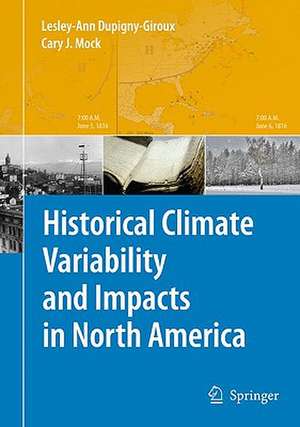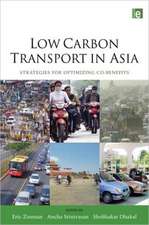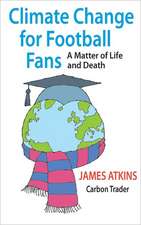Historical Climate Variability and Impacts in North America
Editat de Lesley-Ann Dupigny-Giroux, Cary J. Mocken Limba Engleză Hardback – 16 dec 2009
The four sections begin with regional case studies, and move on to reconstruct extreme events and parameters. This is followed by the role of station history and, lastly, methodologies and other analyses. The editors’ aim has been to produce a volume that would be instrumental in molding the next generation of historical climatologists. They designed this book for use by general researchers as well as in upper-level undergraduate or graduate level courses.
| Toate formatele și edițiile | Preț | Express |
|---|---|---|
| Paperback (1) | 640.24 lei 6-8 săpt. | |
| SPRINGER NETHERLANDS – 26 noi 2014 | 640.24 lei 6-8 săpt. | |
| Hardback (1) | 644.95 lei 6-8 săpt. | |
| SPRINGER NETHERLANDS – 16 dec 2009 | 644.95 lei 6-8 săpt. |
Preț: 644.95 lei
Preț vechi: 758.77 lei
-15% Nou
Puncte Express: 967
Preț estimativ în valută:
123.41€ • 128.86$ • 101.91£
123.41€ • 128.86$ • 101.91£
Carte tipărită la comandă
Livrare economică 16-30 aprilie
Preluare comenzi: 021 569.72.76
Specificații
ISBN-13: 9789048128273
ISBN-10: 9048128277
Pagini: 382
Ilustrații: XIV, 278 p.
Dimensiuni: 155 x 235 x 25 mm
Greutate: 0.54 kg
Ediția:2009
Editura: SPRINGER NETHERLANDS
Colecția Springer
Locul publicării:Dordrecht, Netherlands
ISBN-10: 9048128277
Pagini: 382
Ilustrații: XIV, 278 p.
Dimensiuni: 155 x 235 x 25 mm
Greutate: 0.54 kg
Ediția:2009
Editura: SPRINGER NETHERLANDS
Colecția Springer
Locul publicării:Dordrecht, Netherlands
Public țintă
ResearchCuprins
Regional Case Studies.- The Great Flood of 1771: An Explanation of Natural Causes and Social Effects.- Historical Changes to the Tennessee Precipitation Regime.- “Don’t Want to See No More… Like That!”: Climate Change As a Factor in the Collapse of Lowcountry Rice Culture, 1893–1920.- Climate in the Historical Record of Sixteenth Century Spanish Florida: The Case of Santa Elena Re-examined.- Reconstructing Extreme Events and Parameters.- Historical Accounts of the Drought and Hurricane Season of 1860.- Reconstructing 19th Century Atlantic Basin Hurricanes at Differing Spatial Scales.- The Sitka Hurricane of October 1880.- Daily Synoptic Weather Map Analysis of the New England Cold Wave and Snowstorms of 5 to 11 June 1816.- March 1843: The Most Abnormal Month Ever?.- The Role of Station History in Understanding the Instrumental Record.- Weather Station History and Introduced Variability in Climate Data.- Monitoring the Climate of the Old Northwest: 1820–1895.- Spatial Metadata for Weather Stations and the Interpretation of Climate Data.- Methodologies and Other Analyses.- A Seasonal Warm/Cold Index for the Southern Yukon Territory: 1842–1852.- Backward Seasons, Droughts and Other Bioclimatic Indicators of Variability.- The Challenge of Snow Measurements.
Recenzii
From the reviews:“Readers interested in reconstructing past climate events in the US will find this book a useful reference tool. One realizes, while reading this work, that the ability to fully understand and reconstruct the characteristics of historical climate events/extremes requires a complex and exhaustive research approach. … Most chapters are well referenced, written in fascinating detail, and easy to read. Summing Up: Recommended. Upper-division undergraduates and above with an interest in historical climatology.” (D. Changnon, Choice, Vol. 47 (10), June, 2010)
Notă biografică
Editor Dr. Lesley-Ann Dupigny-Giroux received her Ph.D. in Climatology and Geographic Information Systems from McGill University in 1996 and has since held a variety of professorships and research positions. Dr. Dupigny-Giroux currently serves as the Vermont State Climatologist and teaches at the University of Vermont. She has also authored and co-authored numerous scholarly publications and delivered many presentations. Dr. Dupigny-Giroux is additionally the member of such scientific affiliations as the American Associated of State Climatologists and the American Geophysical Union.
Editor Dr. Cary J. Mock received a Ph.D. in Geography from the University of Oregon in 1994; Dr. Mock has since served as a professor of various courses and has pursued his research interests of synoptic climatology and paleoclimatology among others. Dr. Mock has also written numerous scholarly articles, papers, and other publications. Dr. Mock currently serves as the Principle Investigator for both the National Science Foundation's Earth System History and Paleoclimate Program and the National Oceanic and Atmospheric Administration and the National Climate Data Center.
Editor Dr. Cary J. Mock received a Ph.D. in Geography from the University of Oregon in 1994; Dr. Mock has since served as a professor of various courses and has pursued his research interests of synoptic climatology and paleoclimatology among others. Dr. Mock has also written numerous scholarly articles, papers, and other publications. Dr. Mock currently serves as the Principle Investigator for both the National Science Foundation's Earth System History and Paleoclimate Program and the National Oceanic and Atmospheric Administration and the National Climate Data Center.
Textul de pe ultima copertă
Climatologists with an eye on the past have any number of sources for their work, from personal diaries to weather station reports. Piecing together the trajectory of a weather event can thus be a painstaking process taking years and involving real detective work. Missing pieces of a climate puzzle can come from very far afield, often in unlikely places. In this book, a series of case studies examine specific regions across North America, using instrumental and documentary data from the 17th to the 19th centuries. Extreme weather events such as the Sitka hurricane of 1880 are recounted in detail, while the chapters also cover more widespread phenomena such as the collapse of the Low Country rice culture. The book also looks at the role of weather station histories in complementing the instrumental record, and sets out the methods that involve early instrumental and documentary climate data. Finally, the book’s focus on North America reflects the fact that the historical climate community there has only grown relatively recently. Up to now, most such studies have focused on Europe and Asia.
The four sections begin with regional case studies, and move on to reconstruct extreme events and parameters. This is followed by the role of station history and, lastly, methodologies and other analyses. The editors’ aim has been to produce a volume that would be instrumental in molding the next generation of historical climatologists. They designed this book for use by general researchers as well as in upper-level undergraduate or graduate level courses.
The four sections begin with regional case studies, and move on to reconstruct extreme events and parameters. This is followed by the role of station history and, lastly, methodologies and other analyses. The editors’ aim has been to produce a volume that would be instrumental in molding the next generation of historical climatologists. They designed this book for use by general researchers as well as in upper-level undergraduate or graduate level courses.
Caracteristici
First comprehensive, rigorous historical climatology of North America Complements the current understanding of modern climate change science Includes case studies of specific regions Analyses extreme events and their associated impacts











